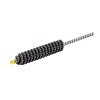Peter M. Eick
Member
We had a long thread a few days back about the new Pro Chucker RCBS 7 station (also a 5 station option) progressive press.
http://www.thehighroad.org/showthread.php?t=771686
Lets not rehash the pros/cons of that thread and just focus on how one would use the seven stations. I started thinking about it and came up with this. I did assume based upon the RCBS manual that expansion and powder drop are not combined into one step like with the pro2000. I don't know if that is true.
For Pistol:
1) Deprime/Size
2) prime/Expand
3) Powder dump
4) Powder check/lockout die
5) seat
6) Initial crimp
7) FCD/Redding Profile Crimper
The other option I came up with:
For Pistol:
1) Deprime/Size
2) prime/Expand
3) Powder dump
4) Powder check/lockout die
5) bullet feeder
6) Seat
7) Crimper
Rifle is harder:
For Pistol:
1) Lube die/Deprime
2) Size
3) Prime/Expand
4) Powder dump
5) Powder check/lockout die
6) seat
7) Crimper
(I like to remove my expanders and do that as a separate step for better runout)
I am sure there are better setups, but I started trying to figure out if the new press is in my future. The first question to me would be how would I use it and where is the upside to dropping $1000 on it vs. primers.
So, lets discuss your station layout and why you put the dies where you did. I figure if we can work out how to use the tool, then the advantages of the tool would be obvious and it will be easier for us to decide to upgrade from our Pro2000's.
To me, the 7 stations gives me the ability to do crimping in two steps instead of one like I can on the pro2000. It also allows me more options on precision with the expansion by not doing it at the same time as powder dispense.
http://www.thehighroad.org/showthread.php?t=771686
Lets not rehash the pros/cons of that thread and just focus on how one would use the seven stations. I started thinking about it and came up with this. I did assume based upon the RCBS manual that expansion and powder drop are not combined into one step like with the pro2000. I don't know if that is true.
For Pistol:
1) Deprime/Size
2) prime/Expand
3) Powder dump
4) Powder check/lockout die
5) seat
6) Initial crimp
7) FCD/Redding Profile Crimper
The other option I came up with:
For Pistol:
1) Deprime/Size
2) prime/Expand
3) Powder dump
4) Powder check/lockout die
5) bullet feeder
6) Seat
7) Crimper
Rifle is harder:
For Pistol:
1) Lube die/Deprime
2) Size
3) Prime/Expand
4) Powder dump
5) Powder check/lockout die
6) seat
7) Crimper
(I like to remove my expanders and do that as a separate step for better runout)
I am sure there are better setups, but I started trying to figure out if the new press is in my future. The first question to me would be how would I use it and where is the upside to dropping $1000 on it vs. primers.
So, lets discuss your station layout and why you put the dies where you did. I figure if we can work out how to use the tool, then the advantages of the tool would be obvious and it will be easier for us to decide to upgrade from our Pro2000's.
To me, the 7 stations gives me the ability to do crimping in two steps instead of one like I can on the pro2000. It also allows me more options on precision with the expansion by not doing it at the same time as powder dispense.




